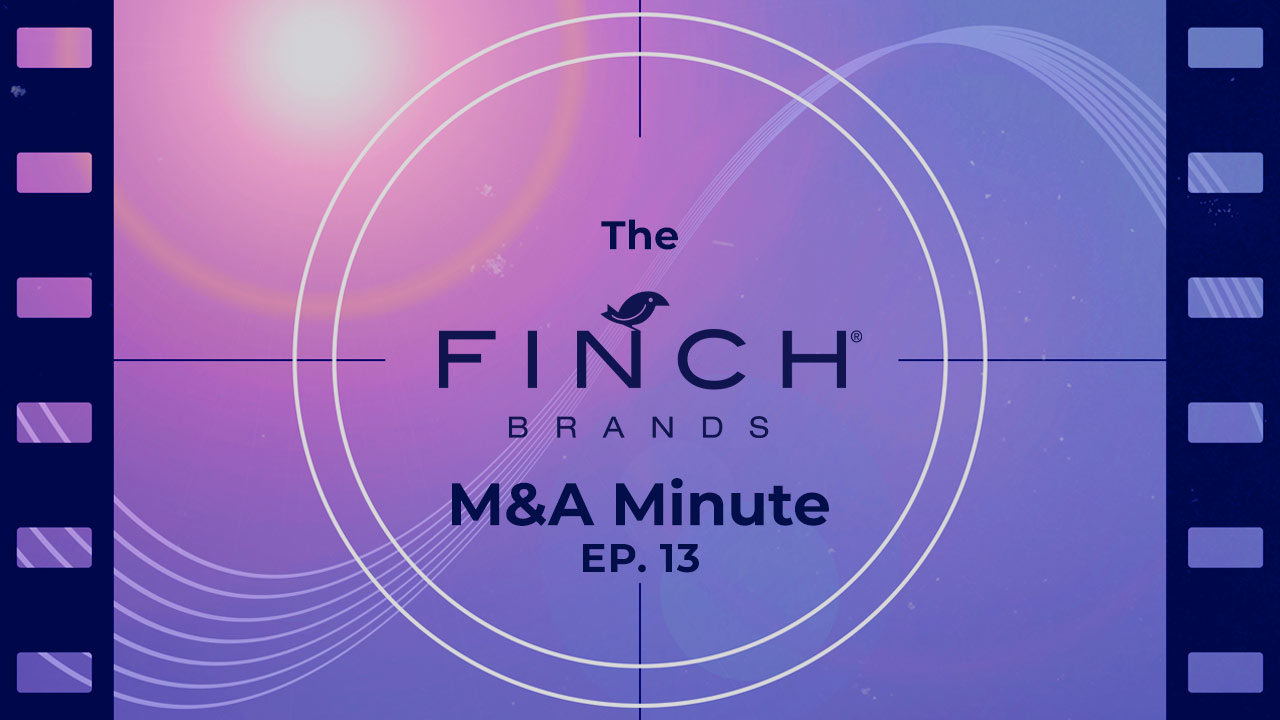M&A Minute: 4 Brand Identity Examples

Welcome to M&A Minute. I’m Bill Gullan, President of Finch Brands, a real-world brand consultancy. The M&A Minute today is a bit of a refresher. There is longer-form content that we’ve created about this. We’re going to focus specifically on the identity choice, nomenclature and logo, in the wake of M&A activity.
How to Navigate Brand Identity Strategies
If one company acquires another or merges with another, there are four main approaches to consider as it relates to how to handle the master brand and corporate brand identity. These can vary depending on your business category, corporate culture, and the nuances of customer and prospect buying decisions.
There are graduations or flavors of these four ways to handle brand identity, but here are the four different directions brands tend to take:
Option One: No Change
The first is No Change. That is when an acquiring company leaves the brand of the acquired company alone and creates a House of Brands approach. They maintain a distinctive name, look, feel, and keep their subbrands.
After the deal is complete, it’s generally best used in consumer categories where there is strong brand awareness or in mature categories where the brands in question are very clearly differentiated and positioned to different customer segments.
One example is Procter & Gamble, a company that has been very aggressive with M&A activity. Their model is to create strong subbrands. Even when they make an acquisition, there’s a lot of back-office consolidation that can take place. But the brands remain distinct.
They believe that because all these brands are so well delineated and positioned differently, if those brands compete against one another and don’t have an obvious linkage, that’s in the best interests of Procter & Gamble.
All the checks go to Cincinnati, but the brands continue to operate behind the scenes in market-facing, distinctive ways. That would be the No Change approach for M&A identity and the top level of the brand architecture.
Option 2: Brand Identity Fusion
The next one is called Fusion. This is where a merger and acquisition transaction happens and there is some integration of brand identity assets into an evolved identity. Think of Conoco Phillips and Exxon Mobil.
This approach is typically geared towards managing risk, more so perhaps than activating potential. They do not want the loyalties of customers or teammates of the acquired entity to be alienated by the departure or the disappearance of the identity of the flag that they’ve been marching under.
Fusion does bring forth something new, but it does, in an overt way, reference the key components of a transaction in ways that connect to heritage and to tradition. If you look at Exxon Mobil, Exxon Mobil merged rather than create something new or rather than elevate one or the other. And that has upsides.
The connection to heritage while simultaneously suggesting something new conveys that everyone within these companies has their fingerprints over the new identity. But one of the downsides of Fusion is that it can be clunky. You have to deal with syllables, trying to bring colors and icons together. And so Fusion, again, has its place in its time, but it also has tradeoffs.
Option 3: Stronger Horse Branding Strategy
The third predominant direction is what we call Stronger Horse. That’s where one brand, which is often the company that initiated the transaction or the most widely known player in the deal, is the name that’s elevated.
That’s a simple, clear, and efficient way to deal with an M&A transition. But there are risks that are fairly obvious. The brand equity and the allegiance of the names that may be sunsetting go away. Customers may be confused or are either not aware of or eager to become part of the larger entity.
Stronger Horse requires a lot for that reason of significant communication to both the team internally as well as the marketplace.
Option 4: Developing a New Brand
The fourth is a new brand that’s developing an entity that is new on the wings of a transaction, and this is usually an approach that’s most appropriate in categories that are undergoing a high degree of transformation.
When GTE and Bell Atlantic merged, they were both broadly known and generally well-regarded long-distance phone companies. But they were envisioning a future of telephones that was moving in the direction of mobile.
Even though both of those brands were well known, there was a transition taking place. The new company was formed to take advantage and lead that transition. So, it made sense to create something new. And that’s what led to Verizon, which was a result of that transaction.
This approach is costly and time-consuming. It’s risky, but it also has the greatest ability to create something that is perceptually new and innovative. It serves to track the further direction of a category, signal that the combined workforce is working together to cross-pollinate ideas and best practices, and create something new.
Option 4a: Reverse Stronger Horse
There are flavors of each option. With Stronger Horse, there’s what’s called the Reverse Stronger Horse, where the acquired company becomes the name. A famous example is when First Union Bank acquired Wachovia.
First Union was much larger and more widely known, but also had some perceptual baggage while Wachovia did not. It was a regional bank that was well-regarded in Winston-Salem, North Carolina. It wasn’t broadly known, but it did have positive equity in its market and an evocative logo look and feel.
When First Union made that acquisition, they ultimately moved forward with the Wachovia name for a period of time, and then First Union went away. Now, that became Wells Fargo.
Make Informed Brand Decisions with Finch Brands
Each brand identity strategy has its place. There’s always strengths as well as trade-offs. This has been M&A Minute. If you have any questions, contact Finch Brands today and subscribe to our YouTube channel for future videos.







